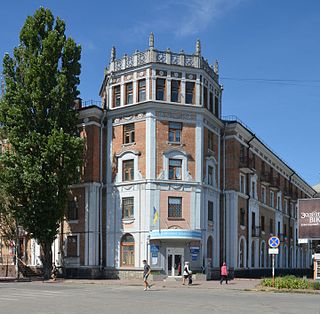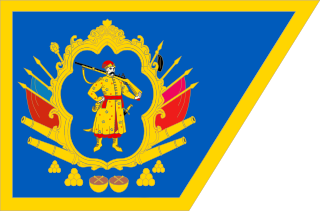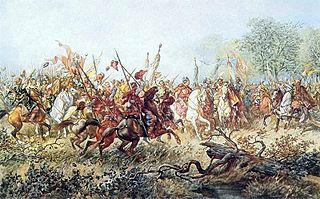
Bohdan Zynoviy Mykhailovych Khmelnytsky was a Ruthenian nobleman and military commander of Zaporozhian Cossacks as Hetman of the Zaporozhian Host, which was then under the suzerainty of the Polish–Lithuanian Commonwealth. He led an uprising against the Commonwealth and its magnates (1648–1654) that resulted in the creation of an independent Cossack state in Ukraine. In 1654, he concluded the Treaty of Pereiaslav with the Russian Tsar and allied the Cossack Hetmanate with Tsardom of Russia, thus placing central Ukraine under Russian protection. During the uprising the Cossacks led a massacre of thousands of Poles and Jews during 1648–1649, making it one of the most traumatic events in the history of the Jews and antisemitism in Ukraine.

Kaniv is a city in Cherkasy Raion, Cherkasy Oblast, central Ukraine. The city rests on the Dnieper River, and is one of the main inland river ports on the Dnieper. It is an urban hromada of Ukraine. Population: 23,172.

The Pereiaslav Agreement or Pereyaslav Agreement was an official meeting that convened for a ceremonial pledge of allegiance by Cossacks to the Russian tsar, then Alexis, in the town of Pereiaslav in central Ukraine, in January 1654. The ceremony took place concurrently with ongoing negotiations that started on the initiative of Hetman Bohdan Khmelnytsky to address the issue of the Cossack Hetmanate with the ongoing Khmelnytsky Uprising against the Polish–Lithuanian Commonwealth and which concluded the Treaty of Pereiaslav. The treaty itself was finalized in Moscow in April 1654.

Hetman of Zaporizhian Cossacks is a historical term that has multiple meanings.

The Zaporozhian Sich was a semi-autonomous polity and proto-state of Cossacks that existed between the 16th to 18th centuries, including as an autonomous stratocratic state within the Cossack Hetmanate for over a hundred years, centred around the region now home to the Kakhovka Reservoir and spanning the lower Dnieper river in Ukraine. In different periods the area came under the sovereignty of the Polish–Lithuanian Commonwealth, the Ottoman Empire, the Tsardom of Russia, and the Russian Empire.

Nikopol is a city and municipality (hromada) in Nikopol Raion in the south of Ukraine, on the right bank of the Dnieper River, about 63 km south-east of Kryvyi Rih and 48 km south-west of Zaporizhzhia. Population: 105.160.

The Cossack Hetmanate, officially the Zaporozhian Host, is a historical term for the 17th–18th centuries Zaporozhian Cossacks state located in today's central Ukraine. It existed between 1649 and 1764, although its administrative-judicial system persisted until 1781.

Zvenyhorodka is a city in Cherkasy Oblast, central Ukraine, situated on the Hnylyi Tikych River. The town is the administrative center of Zvenyhorodka Raion. It hosts the administration of Zvenyhorodka urban hromada, one of the hromadas of Ukraine. The city has a population of 16,269.
Stebliv is a rural settlement in Zvenyhorodka Raion, Cherkasy Oblast, central Ukraine. It hosts the administration of Stebliv settlement hromada, one of the hromadas of Ukraine. The townlet rests at a bend on the Ros River, some 16 kilometres (9.9 mi) from Korsun-Shevchenkivskyi. Population: 3,280.

Yurii Khmelnytsky, younger son of the famous Ukrainian Hetman Bohdan Khmelnytsky and brother of Tymofiy Khmelnytsky, was a Zaporozhian Cossack political and military leader. Although he spent half of his adult life as a monk and archimandrite, he also was Hetman of Ukraine on several occasions — in 1659-1660 and 1678–1681 and starost of Hadiach, becoming one of the most well-known Ukrainian politicians of the "Ruin" period for the Cossack Hetmanate.

Stavyshche is a rural settlement in Bila Tserkva Raion, Kyiv Oblast (province) in northern Ukraine, on the Hnylyi Tikych river. It hosts the administration of Stavyshche settlement hromada, one of the hromadas of Ukraine. Population: 6,056 . In 2001, population was 7,929.

The History of Cherkasy Oblast of central Ukraine has a long history spanning all the way back to prehistoric times. Archaeological discoveries, have shown that people have inhabited the valley of the Dnieper (Dnipro) River since the times immemorial. The oldest objects excavated on the territory of the region date back to the Stone Age.

The Battle of Zhovti Vody was the first significant battle of the Khmelnytsky Uprising. Near the site of the present-day city of Zhovti Vody on the Zhovta River in Ukraine, the forces of the Zaporozhian Host and Crimean Khanate under the command of Hetman Bohdan Khmelnytsky, Colonels Mykhailo Krychevsky, Maksym Kryvonis, and Fylon Dzhalaliy with Tugay Bey attacked and defeated the Polish–Lithuanian Commonwealth's forces under the command of Hetman Stefan Potocki and General Stefan Czarniecki, both of them were captured in the battle by the Zaporozhian Cossacks and Crimean Tatars.

The Battle of Korsuń was the second significant battle of the Khmelnytsky Uprising. Near the site of the present-day city of Korsun-Shevchenkivskyi in Ukraine, a forces of the Zaporozhian Host and Crimean Khanate under the command of Hetman Bohdan Khmelnytsky, Colonels Mykhailo Krychevsky, Ivan Bohun, Maksym Kryvonis, Martyn Pushkar, Matviy Hladky and Mykhailo Hromyka with Tugay Bey attacked and defeated the Polish–Lithuanian Commonwealth’s forces under the command of Hetmans Mikołaj Potocki and Marcin Kalinowski, both of them was captured in the battle by the Zaporozhian Cossacks and Crimean Tatars. As in the Battle of Zhovti Vody in 29 April — 16 May, 1648 the Polish–Lithuanian Commonwealth’s forces took a defensive position, retreated and were thoroughly routed and destroyed by the forces of the Zaporozhian Host and Crimean Khanate.

Subotiv is a village (selo) in central Ukraine. It is located in Cherkasy Raion (district) of Cherkasy Oblast (province), near the town of Chyhyryn. It belongs to Chyhyryn urban hromada, of which the administration is located in Chyhyryn.

The Chyhyryn Regiment was one of the seventeen territorial-administrative subdivisions of the Hetman State. The regiment's capital was the city of Chyhyryn, now in the Cherkasy Oblast of central Ukraine. The military units of the regiment were also known as the Hetman's Guard serving as personal guards of the Hetman of Ukraine in 1648–1676.

Ottoman Ukraine, Khan Ukraine, Hanshchyna was the right-bank Ukraine, also known by its Turkic name Yedisan. The first recorded use of the term Khanska Ukraina are traced to 1737 when the Russian secret-agent Lupul urged Empress Anna of Russia to attack Ottoman Ukraine.

The Truce of Zamość was signed on November 20, 1648 during the siege of Zamość between the King of Poland John II Casimir of Poland and the Hetman of Zaporizhian Host Bohdan Khmelnytsky.

Joseph Tukalskyi-Nelyubovych, was a political and religious leader of the Cossack Hetmanate and the last Metropolitan of Kyiv, Galicia and all Rus in the Ecumenical Patriarchate of Constantinople in the Eastern Orthodox Church.

The Kaniv Regiment was a regiment of the Registered Cossacks (1625–1638) and later also an administrative subdivision of the Cossack Hetmanate. It was centred around the town of Kaniv in central Ukraine, on the banks of the Dnieper river.

































